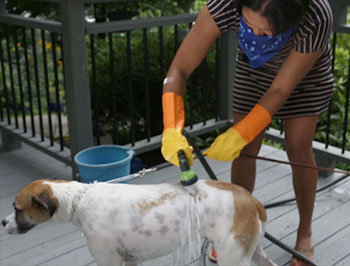Be Ready for Radiation Emergencies

Protect yourself, your loved ones, and your pets during a radiation emergency by getting inside, staying inside, and staying tuned.
It’s Saturday night and you’re at home with your family watching TV. A news alert announces a radiation emergency in your city. It could be an overturned truck hauling radioactive material, a nuclear power plant accident, or a “dirty bomb,” but reports are that large amounts of radiation have been released. What should you do?
Radiation can affect the body in a number of ways, and the adverse health effects of exposure may not be apparent for many years. These can range from mild effects, such as skin reddening, to serious effects such as cancer and death. This depends on the amount of radiation absorbed by the body (the dose), the type of radiation, and for how long the person was exposed. In large doses, radiation can cause acute illness or skin burns, or jeopardize a developing fetus.
Knowing the right steps to take can save lives and protect health.
Get Inside
Get inside a building and take shelter for a period of time instead of leaving. The walls of your home can block much of the harmful radiation. Because radioactive materials become weaker over time, staying inside for at least 24 hours can protect you and your family until it is safe to leave the area.
Stay Inside
Getting inside of a building and staying there is called “sheltering in place.” Once you get in a building, there are things you can do to stay safe inside. Always listen for additional instructions from emergency officials and radiation experts. Decontaminating yourself will lower your exposure to harmful radioactive material. Even just removing your outer layer of clothing can remove up to 90% of radioactive material.
If you have loved ones in schools, day cares, hospitals, nursing homes, or other facilities during a radiation emergency, stay where you are! Going outside to get loved ones could expose you and them to dangerous levels of radiation. Children and adults in schools, daycares, hospitals, nursing homes, or other places will be instructed to stay inside until emergency responders know that it is safe to evacuate. Facilities have plans in place to keep everyone safe inside.
Stay Tuned
It will be important to stay tuned once you get inside for updated instructions from emergency response officials. As officials learn more about the emergency, they will be communicating the latest information to the public. Television, radio, and social media are some examples of ways that you may receive information.
You should not leave your building or place of shelter until officials or emergency responders have said it is safe, unless you have a life-threatening condition.
Be Prepared for a Radiation Emergency
What can you do before a radiation emergency happens so that you are prepared? At home, put together an emergency kit that would be appropriate for any emergency. A battery-powered or hand crank emergency radio, preferably a National Oceanic and Atmospheric Administration (NOAA) weather radio is important to have for any emergency situation.
Check with your community leaders, child’s school, the nursing home of a family member, and your employer to see what their plans are for dealing with a radiation emergency.
























.png)











No hay comentarios:
Publicar un comentario